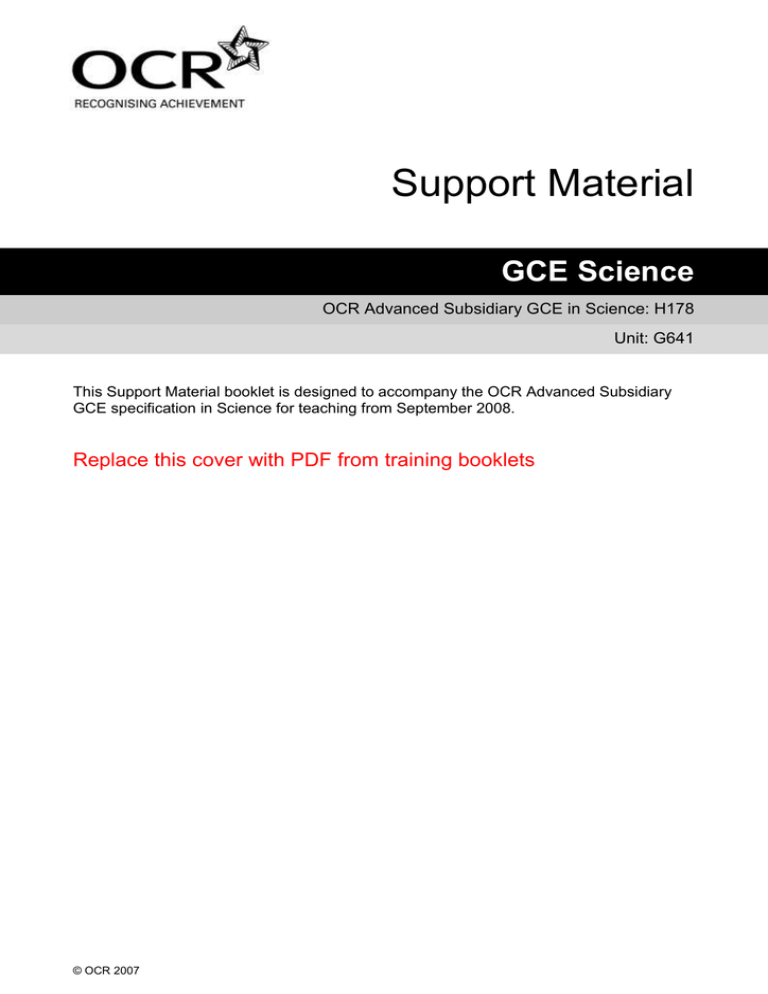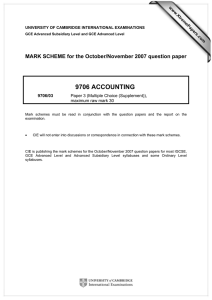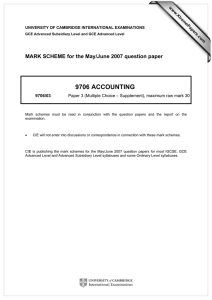Unit G641 - Remote sensing and the natural environment - Scheme of work and lesson plan booklet (DOC, 2MB)
advertisement

Support Material GCE Science OCR Advanced Subsidiary GCE in Science: H178 Unit: G641 This Support Material booklet is designed to accompany the OCR Advanced Subsidiary GCE specification in Science for teaching from September 2008. Replace this cover with PDF from training booklets © OCR 2007 Contents Contents 2 Introduction 3 GCE Science: H178:G641 Remote Sensing and the Natural Environment 5 GCE Science: H178: G641 Remote Sensing and the Natural Environment 8 Sample GCE Lesson Plan Science H178 Remote Sensing and the Natural Environment G641: Module 2, Stable and Vulnerable Ecosystems 14 Other forms of Support 16 2 of 18 GCE Science Introduction Background A new structure of assessment for A Level has been introduced, for first teaching from September 2008. Some of the changes include: The introduction of stretch and challenge (including the new A* grade at A2) – to ensure that every young person has the opportunity to reach their full potential The reduction or removal of coursework components for many qualifications – to lessen the volume of marking for teachers A reduction in the number of units for many qualifications – to lessen the amount of assessment for learners Amendments to the content of specifications – to ensure that content is up-to-date and relevant. OCR has produced an overview document, which summarises the changes to Science. This can be found at www.ocr.org.uk, along with the new specification. In order to help you plan effectively for the implementation of the new specification we have produced this Scheme of Work and Sample Lesson Plans for Science. These Support Materials are designed for guidance only and play a secondary role to the Specification. Our Ethos All our Support Materials were produced ‘by teachers for teachers’ in order to capture real life current teaching practices and they are based around OCR’s revised specifications. The aim is for the support materials to inspire teachers and facilitate different ideas and teaching practices. Each Scheme of Work and set of sample Lesson Plans is provided in: PDF format – for immediate use Word format – so that you can use it as a foundation to build upon and amend the content to suit your teaching style and students’ needs. The Scheme of Work and sample Lesson plans provide examples of how to teach this unit and the teaching hours are suggestions only. Some or all of it may be applicable to your teaching. The Specification is the document on which assessment is based and specifies what content and skills need to be covered in delivering the course. At all times, therefore, this Support Material booklet should be read in conjunction with the Specification. If clarification on a particular point is sought then that clarification should be found in the Specification itself. GCE Science 3 of 18 A Guided Tour through the Scheme of Work = Innovative Teaching Idea All the teaching ideas contained in the SOW are innovative, but the icon is used to Highlight exceptionally innovative ideas. = Stretch & Challenge Activity This icon is added at the end of text when there is an explicit opportunity to offer Stretch and Challenge. = ICT Opportunity This icon is used to illustrate when an activity could be taught using ICT facilities. 4 of 18 GCE Science GCE Science: H178: G641 Remote Sensing and the Natural Environment Suggested teaching time 20 hours Topic outline 1.1.1 Wave properties, and the Electromagnetic spectrum Module 1: Sensing the environment using electromagnetic radiation: Emission & detection of visible and non-visible radiation; the electromagnetic spectrum. Topic Interpreting space and satellite images Suggested teaching and Suggested resources Points to note homework activities Wave features: Absorb Physics CD-Rom Slinky spring ,length of rope diffraction, Advanced Physics, Patrick Fuller, Text books reflection Heinemann Software packages refraction Ripple tank model wave and ray diagrams Internet resources prisms, diffraction grating to obtain colour http://physicsspectrum animations.com/Physics/English/waves.htm Receptor cells in then eye = Innovative teaching idea GCE Science Receptor cells in the eye, rods & cones, response curves http://www.physicsclassroom.com/Class/wav es/wavestoc.html Laser beam diffraction. Biology text book ( for structure of the eye) = Stretch and challenge opportunity idea = ICT opportunity 5 of 18 GCE Science: H178: G641 Remote Sensing and the Natural Environment Suggested teaching time 20 hours Topic outline Wave equation Energy Transfer Module 1: Sensing the environment using electromagnetic radiation: Emission & detection of visible and non-visible radiation; the electromagnetic spectrum. Topic Interpreting space and satellite images Suggested teaching and Suggested resources Points to note homework activities frequency Wave calculations in standard form, use Standard form will need to be taught with examples from across the EMS to become exemplars wavelength familiar with range of standard forms speed wave equation, c=f Energy transfer by radiation Energy absorption by pigments such as chlorophyll Electromagnetic Spectrum Electromagnetic spectrum – wall chart of regions Properties of the regions 1.1.2 Interpreting space and satellite images Earth images in various EMS regions Thermal images False colour images = Innovative teaching idea 6 of 18 Radiant heater Colorimeter qualitative work only Absorption spectrum from web Colorimeter plot of coloured solutions Interactive EMS from internet. http://www3.interscience.wiley.com:8100/lega cy/college/strahler/0471669695/animations/ch 02/animation1.htm (shockwave) Opportunity for student led discussion about regions Research on properties and problems of EMS regions Uses as energy transfer, e.g. radio, mobile phone, TV remote, etc Various image forms from different sources = Stretch and challenge opportunity idea = ICT opportunity GCE Science GCE Science: H178: G641 Remote Sensing and the Natural Environment Suggested teaching time Topic outline 20 hours Module 1: Sensing the environment using electromagnetic radiation: Emission & detection of visible and non-visible radiation; the electromagnetic spectrum. Topic Interpreting space and satellite images Suggested teaching and Suggested resources Points to note homework activities Limitations of imaging: Absorption, scattering, diffraction, pixel Response data for photographic film, CCD density Be aware of device sensitivity: human eye, and human eye. photographic film, charge-coupled devices = Innovative teaching idea GCE Science = Stretch and challenge opportunity idea = ICT opportunity 7 of 18 GCE Science: H178: G641 Remote Sensing and the Natural Environment Suggested teaching time 16 hours Topic outline Module 2: Stable and Vulnerable Ecosystems Energy balances and flows in cells and ecosystems Topic Nutrient cycles in ecosystems and agriculture Biodiversity and ecosystems Suggested teaching and homework Suggested resources activities OCR AS Science, David Goodfellow, Heinemann (Summer 2008) http://science.nhmccd.edu/biol/bio1int.htm has a list of various animations. 1.2.1 Energy Balances and flows in cells and ecosystems Cells :Function of major cell bodies Plasma (cell) membrane Mitochondria Chloroplasts (plant cells) cytoplasm Photosynthesis chlorophyll absorbs light from sun conversion of H2O into H atoms, O2 and ATP CO2 conversion to glucose Review individually what organelles are in a cell and what their function is Review the knowledge of organelles in eukaryotic cells and introduce their importance within the cell. Cut ‘n’ stick activity: Pairing of the organelles structure to its function The teacher should put an emphasis on the interrelationship between the organelles involved in the production and secretion of proteins Photographs of different cell types: epithelial cell, spongy mesophyll cell, erythrocyte, leucocyte, sperm cell, etc. Single celled organisms such as Paramecium can be used to further test students understanding Both organelle structure and function given or Colorimeter for absorption spectrum of chlorophyll solution Calvin Cycle – create large diagram with stages labelled. 8 of 18 Teacher can refer to the BBC website for diagrams of cell and their organelles: http://www.bbc.co.uk/education/asguru/biol ogy Students research to find organelle function ( or food colourings could be used as a faster source of dyes to show the different absorption patterns – Link to Module 1, EMS) Transfer of energy into a stored = Innovative teaching idea Points to note = Stretch and challenge opportunity idea Website animations www.fw.vt.edu/dendro/forestbiology/ph otosynthesis http://www.science.smith.edu/departme nts/Biology/Bio231/calvin3.swf http://www.science.smith.edu/departme nts/Biology/Bio231/ltrxns3.swf = ICT opportunity GCE Science GCE Science: H178: G641 Remote Sensing and the Natural Environment Suggested teaching time 16 hours Topic outline Module 2: Stable and Vulnerable Ecosystems Energy balances and flows in cells and ecosystems Topic Nutrient cycles in ecosystems and agriculture Biodiversity and ecosystems Suggested teaching and homework Suggested resources activities Points to note form Energy flow Energy transfer Conservation of energy Energy storage and energy dissipation Autotrophs Explain the term autotroph and describe examples of Photosynthesising organisms Organisms that use chemical reactions as primary energy sources = Innovative teaching idea GCE Science Continues from block above, use the large diagram to show regions where these changes occur. Look up as a keyword and find examples of such organisms http://www.ftexploring.com/photosyn/photo synth.html (much info on this site, with some excellent links at a range of levels) ] http://ksuweb.kennesaw.edu/~vking2/Photo synthesisandCellularRespirationpost.ppt = Stretch and challenge opportunity idea = ICT opportunity 9 of 18 GCE Science: H178: G641 Remote Sensing and the Natural Environment Suggested teaching time 16 hours Topic outline Respiration Module 2: Stable and Vulnerable Ecosystems Energy balances and flows in cells and ecosystems Topic Nutrient cycles in ecosystems and agriculture Biodiversity and ecosystems Suggested teaching and homework Suggested resources activities Students should state that plasma (cell surface) membranes are partially permeable barriers Biosynthesis (including proteins) Movement Active transport across cell membranes Explain the concept of passive transport and active transport Diffusion down a concentration gradient Role of carrier proteins & protein channels Group the students giving each a type of transport to research and produce resources and a presentation for the rest of the class Active transport against a concentration gradient and the requirement for energy transfer Summarise the findings of the students Yeast practical work to compare types of respiration. Processes of respiration Site of respiration ATP from glucose conversion ATP as mobile energy store Anaerobic and aerobic respiration comparison Different conditions = Innovative teaching idea 10 of 18 Demonstrate the diffusion of gas within a room and diffusion of dye pigment in liquid, e.g. food dye in cylinder of water, menthol or camphor crystals for vapour. Points to note http://www.stolaf.edu/people/giannini/biolog ical%20anamations.html [site has links to various animations, note spelling in web address !] http://www.sp.uconn.edu/~terry/Common/r espiration.html http://www.northland.cc.mn.us/biology/Biol ogy1111/animations/glycolysis.html http://www.northland.cc.mn.us/biology/Biol ogy1111/animations/transport1.html See internet resources above, and any ALevel Biology text book http://www.jdenuno.com/APBiology/Labs/Y eastRespiration.doc [a practical experiment with yeast cells] http://www.dgs.edu.hk/QEF_Sc/Manuals/Bi ology/TM1--yeast%20resp.pdf [yeast, measure rate of CO2 formation, can use bubble count instead of pressure sensor, but need to saturate water first with sodium = Stretch and challenge opportunity idea = ICT opportunity GCE Science GCE Science: H178: G641 Remote Sensing and the Natural Environment Suggested teaching time 16 hours Topic outline Module 2: Stable and Vulnerable Ecosystems Energy balances and flows in cells and ecosystems Topic Nutrient cycles in ecosystems and agriculture Biodiversity and ecosystems Suggested teaching and homework Suggested resources activities Points to note hydrogen carbonate to reduce dissolving of CO2] Energy Flow Interpret data and energy flow diagrams to show understanding of Energy storage Conservation of energy Dissipation of energy Energy Transfer Ecosystems Explain and use the terms Calculate from given data estimated energy transfer values in an ecosystem = Innovative teaching idea GCE Science Draw food chain diagrams, or collect from internet. Estimate energy flow at each stage] http://www.uwsp.edu/cnr/wcee/keep/Mod1/Flow/fo odchains.htm = Stretch and challenge opportunity idea http://www.globalchange.umich.edu/globalc hange1/current/lectures/kling/energyflow/hi ghertrophic/trophic2.html a range of resources at various levels – some is challenging = ICT opportunity 11 of 18 GCE Science: H178: G641 Remote Sensing and the Natural Environment Suggested teaching time 16 hours Topic outline Nitrogen Cycle Human Influences Haber process = Innovative teaching idea 12 of 18 Module 2: Stable and Vulnerable Ecosystems Energy balances and flows in cells and ecosystems Topic Nutrient cycles in ecosystems and agriculture Biodiversity and ecosystems Suggested teaching and homework Suggested resources activities Discuss and create a detailed nitrogen cycle, research from text books and internet. Include leaching and harvesting. Other nutrient elements for plant growth Role of decomposers Experimental work on different soil samples (students bring in small samples) using mineral test kits, pH test. Negative and positive feedback and examples of their effect on soil nutrients Data analysis on nutrient inputs and outputs. Review the Haber process, including conditions and equations Construct a labelled diagram. Review from GCSE the reasons for the conditions. Explore rising world population (internet) and the need for more food. Discuss other implications of Haber Points to note http://www.npr.org/programs/morning/features/200 2/jul/fritzhaber/enlarge.html History and development: http://www.princeton.edu/~hos/mike/texts/readmach/r eadmachfr.htm http://www.npr.org/programs/morning/features/2002/ju l/fritzhaber/ Haber Process: http://en.wikipedia.org/wiki/Haber_process http://www.bbc.co.uk/schools/gcsebitesize/chemistry/ usefulproductsair/ammonia_haberrev3.shtml http://ferl.qia.org.uk/content_files/ferl/resources/colleg es/vardeancollege/articles/jfrood/ferl_1619/habermovi = Stretch and challenge opportunity idea = ICT opportunity GCE Science GCE Science: H178: G641 Remote Sensing and the Natural Environment Suggested teaching time 16 hours Topic outline Module 2: Stable and Vulnerable Ecosystems Energy balances and flows in cells and ecosystems Topic Nutrient cycles in ecosystems and agriculture Biodiversity and ecosystems Suggested teaching and homework Suggested resources activities Process – explosives and weapons Points to note e.swf Food and population: http://www.efma.org/Publications/10anniversary/Secti on02.asp http://www.peopleandplanet.net/doc.php?id=2532 Human Influences Eutrophication = Innovative teaching idea GCE Science Explore what eutrophication is; the effects of human activity, and how these can be mitigated. Opportunity for student presentation on findings. http://www.efma.org/Publications/10anniversary/Secti on04.asp http://en.wikipedia.org/wiki/Eutrophication http://www.water-pollution.org.uk/eutrophication.html http://openlearn.open.ac.uk/course/view.php?id=2811 http://www.chemgapedia.de/vsengine/vlu/vsc/en/ch/1 6/uc/vlus/eutrophication.vlu.html http://bio150.chass.utoronto.ca/labs/coollinks/lab7.htm (overview) = Stretch and challenge opportunity idea = ICT opportunity 13 of 18 Sample GCE Lesson Plan Science H178 Remote Sensing and the Natural Environment G641: Module 2, Stable and Vulnerable Ecosystems Nutrient cycles in ecosystems and agriculture OCR recognises that the teaching of this qualification will vary greatly from school to school and from teacher to teacher. With that in mind, this lesson plan is offered as a possible approach but will be subject to modifications by the individual teacher. Lesson length is assumed to be one hour, Learning Objectives for the lesson Objective 1 Describe and explain the need for added nitrogen in the natural nitrogen cycle [nitrogen fixation] Objective 2 Describe the Haber process, including raw materials and conditions Objective 3 State that the ammonia can be converted into nitrate Objective 4 Describe the process and impact of eutrophication Recap of previous experience and prior knowledge Students have studied the nitrogen cycle, including input and output sources and are aware of the importance of nitrogen in crop production. Private study work has previously been to review the Haber process and its operating conditions via internet and/or text books. Content Time Content 15 minutes Teacher to collect and list student ideas for natural nitrogen inputs and major food crop outputs. Review need for added nitrogen to maintain food supply. Complete block diagram of the Haber process with details now added, including the output of ammonia into nitric acid then to nitrates as fertilisers. Research in pairs the process of eutrophication and the impact of eutrophication on ecosystem biodiversity. Create a block diagram of eutrophication and its impact by student input to class discussion 25 minutes 10 minutes 14 of 18 GCE Science Consolidation Time Content 10 minutes GCE Science Review eutrophication and its effects on the environment [water courses, aquatic life]. Introduce idea of health impact on humans. Set Private study on research topic on nitrates in drinking water and their effect on health 15 of 18 Other forms of Support In order to help you implement these new specification effectively, OCR offers a comprehensive package of support. This includes: OCR Training Get Ready…introducing the new specifications A series of FREE half-day training events are being run during Autumn 2007, to give you an overview of the new specifications. Get Started…towards successful delivery of the new specifications These full-day events will run from Spring 2008 and will look at the new specifications in more depth, with emphasis on first delivery. Visit www.ocr.org.uk for more details. Hosted Network Events OCR runs a number of successful network events, hosted by our Customer Support Managers. These enable you to meet colleagues from other centres and share best practice. The events are about peer learning and provide an excellent opportunity to carry out standardisation activities and receive updates from OCR. For more information, please contact the Networks and Regional Coordinator on 024 7649 6396. Mill Wharf Training Additional events are also available through our partner, Mill Wharf Training. It offers a range of courses on innovative teaching practice and whole-school issues - www.mill-wharf-training.co.uk. e-Communities Over 70 e-Communities offer you a fast, dynamic communication channel to make contact with other subject specialists. Our online mailing list covers a wide range of subjects and enables you to share knowledge and views via email. Visit https://community.ocr.org.uk, choose your community and join the discussion! 16 of 18 GCE Science Interchange OCR Interchange has been developed to help you to carry out day to day administration functions online, quickly and easily. The site allows you to register and enter candidates online. In addition, you can gain immediate a free access to candidate information at you convenience. Sign up at https://interchange.ocr.org.uk Published Resources Published Resources OCR offers centres a wealth of quality published support with a fantastic choice of ‘Official Publisher Partner’ and ‘Approved Publication’ resources, all endorsed by OCR for use with OCR specifications. Publisher partners OCR works in close collaboration with three Publisher Partners: Hodder, Heinemann and Oxford University Press (OUP), to ensure centres have access to: Better published support, available when you need it, tailored to OCR specifications Quality resources produced in consultation with OCR subject teams, which are linked to OCR’s teacher support materials More resources for specifications with lower candidate entries Materials that are subject to a thorough quality assurance process to achieve endorsement Heinemann is the exclusive publisher partner for OCR GCE AS Science. Heinemann is producing the following resources for OCR GCE Science for first teaching in September 2008. Goodfellow D. AS Science ISBN: 978 0 435691 79 0 Endorsement OCR endorses a range of publisher materials to provide quality support for centres delivering its qualifications. You can be confident that materials branded with OCR’s “Official Publishing Partner” or “Approved publication” logos have undergone a thorough quality assurance process to achieve endorsement. All responsibility for the content of the publisher’s materials rests with the publisher. GCE Science 17 of 18 These endorsements do not mean that the materials are the only suitable resources available or necessary to achieve an OCR qualification. Any resource lists which are produced by OCR shall include a range of appropriate texts. 18 of 18 GCE Science


